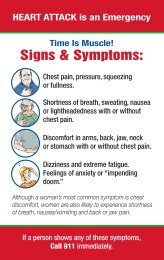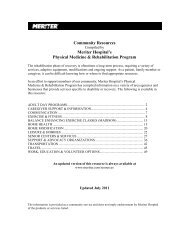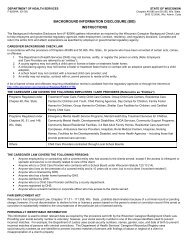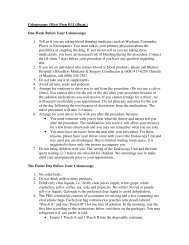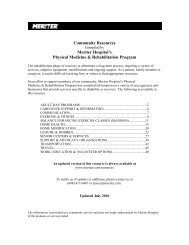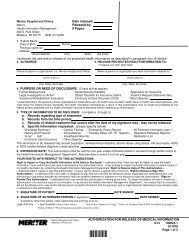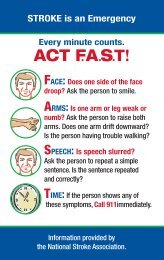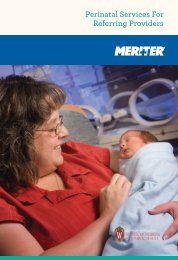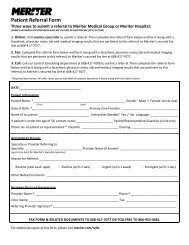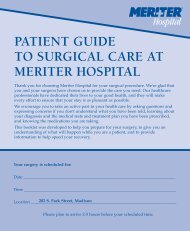A Guide To Your New Family's First Weeks - Meriter Health Services
A Guide To Your New Family's First Weeks - Meriter Health Services
A Guide To Your New Family's First Weeks - Meriter Health Services
You also want an ePaper? Increase the reach of your titles
YUMPU automatically turns print PDFs into web optimized ePapers that Google loves.
Sleeping<br />
<strong>New</strong>borns sleep an average of 13-14 hours out of 24<br />
hours. They will usually have one sleep stretch of four<br />
to five hours. Their sleep pattern is irregular during the<br />
early weeks. Between six weeks to three months, they<br />
may begin to sleep more hours during the night.<br />
<strong>Your</strong> baby may have her days and nights mixed up. <strong>To</strong><br />
encourage more nighttime sleep, try the following:<br />
• Wake your baby up at least every three hours during<br />
the day and evening. This reduces the number of<br />
hours slept and will allow your baby to eat more<br />
frequently during these hours.<br />
• During the night, minimize stimulation when your<br />
baby awakes. Keep lights low, feed your baby in the<br />
same room she sleeps in, talk softly and minimally,<br />
keep baby warm and change her diaper only if<br />
necessary.<br />
Reducing The Risk Of Sudden Infant<br />
Death Syndrome (SIDS)<br />
What is SIDS<br />
• It is the sudden death of an infant under 1 year,<br />
which remains unexplained after a thorough case<br />
investigation that includes a complete autopsy,<br />
examination of the death scene and review of the<br />
clinical history.<br />
• It is rare during the first month, peaks between the<br />
second and third months, then decreases.<br />
• Since 1994, when the Back-to-Sleep program was<br />
introduced, there has been a 50% reduction in SIDS.<br />
Risk Factors for SIDS<br />
• Maternal smoking during pregnancy and exposure to<br />
cigarette smoke in infancy<br />
• Sleeping on stomach<br />
• Sleeping on a soft surface and/or blankets/bedding<br />
over face<br />
• Overheating due to warm environmental<br />
temperature or over-bundling<br />
• Late or no prenatal care<br />
• Young maternal age<br />
• Preterm or low birth weight infants<br />
Infant Sleep<br />
Although we associate the phrase “sleep like a baby” with good sleep, your newborn’s sleep behaviors will likely leave<br />
you yearning for more sleep! Usually it takes months for your baby to develop a sleep pattern and begin to sleep long<br />
hours during the night.<br />
While in the hospital, infants are required to sleep<br />
independently in their crib<br />
Reducing The Risk Of SIDS<br />
1. Place infant to sleep on his back. Side or stomach<br />
sleeping are not considered safe positions for<br />
infants.<br />
2. Use a firm sleep surface.<br />
3. Keep soft objects and loose bedding out of the crib.<br />
4. Do not smoke during pregnancy.<br />
5. We recommend a separate, but proximate,<br />
sleeping environment.<br />
• The American Academy of Pediatrics recommends<br />
that the infant’s crib, bassinet, or co-sleeper be<br />
placed in the parents’ bedroom.<br />
• Sharing the bed with your baby is not<br />
recommended.<br />
• While in the hospital, infants are required to<br />
sleep independently in their crib.<br />
• Parents of multiples should place babies in<br />
separate cribs.<br />
6. Consider offering a pacifier at naptime and<br />
bedtime.<br />
• One SIDS death can be prevented for every 2,700<br />
infants who use a pacifier when placed for sleep.<br />
• Use the pacifier when placing the infant down for<br />
sleep and do not reinsert it once the infant falls<br />
asleep.<br />
• If the infant refuses the pacifier, do not force your<br />
baby to take it.<br />
• Do not coat pacifiers in any sweet solution.<br />
• Clean pacifiers often and replace them regularly.<br />
• Delay pacifier introduction for breastfed infants<br />
until one month of age to ensure that breastfeeding<br />
is firmly established.<br />
7. Avoid overheating.<br />
8. Avoid commercial devices marketed to reduce the<br />
risks of SIDS.<br />
9. Do not use home monitors as a strategy to reduce<br />
the risk of SIDS.<br />
10.Avoid development of flat head by encouraging<br />
tummy time, avoiding excessive time in car carriers<br />
and bouncers and alternating the side of the head<br />
your infant sleeps on.<br />
52



